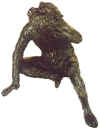|

Copyright Reunion
des Musees Nationaux, Paris
In respect of the Louvre monkey
which Giambologna experts suggest comes from the Fountain, it is best to ask simple
questions. Is it life-like? Should it be life-like? Is the fur convincing? Should the pose
of this monkey resemble the pose of any of the monkeys in the Uffizi drawing? Is there
evidence it has been in a damp environment? Are there yellow deposits, stains, etc? The
left leg is held out at an oblique angle and the underside is fashioned in a curve that
would require support. The Louvre uses a wedge to counteract this curve. A pedestal base
would raise the right hand so it would not touch the ground but be suspended in the air.
The head of the Louvre monkey does not look ahead but to one side and up. The face of the
Louvre monkey is usually seen from a photograph taken from the side but this is not how it
would be seen head on in the niche. Is the monkey designed to be seen successfully from
all angles? Is the quality high enough to be by one of the greatest sculptors in bronze of
the Renaissance? Does the Louvre monkey fit the niche? Height of niche 18 ½ inches (47
cm), height of Louvre monkey 16 inches (40.7 cm); width of niche 10 ¾ inches (27.3 cm),
width of Louvre monkey 14 inches (35.6 cm); depth of niche 7 inches (17.8 cm), depth of
Louvre monkey 11 inches (28 cm). The metal has been tested to be old and its unrefined
nature would support this. The Louvre monkey is a Macaque Sylvanus (Barbary ape), a type
which has no tail.
|